|
|
| 'Like' us on Facebook | Follow us: |
Posted on : Mar 13, 2012
CURE FROM VENOM THROUGH LOVE AND CARE
How a poor farm worker was rescued from the
jaws of death at Baba's hospital after a lethal snake bite
Bhagawan Baba laid the foundation stone for the Sri Sathya Sai General Hospital in Puttaparthi at a time when this rural hamlet was as unknown and obscure as the Pitcairn islands in the Pacific Ocean. After centuries of colonial rule, India gained independence in 1947 and it had barely come out of her painful past, let alone take great strides in development in 1954, when Baba decided to construct a hospital for the innocent village folk of Puttaparthi. That infact was the humble beginning of the marvellous Sri Sathya Sai Medical Mission of which the two super speciality hospitals, one each in Puttaparthi and Whitefield, are the shining lighthouses.
The SSS General Hospital nevertheless continues to be the lifeline of thousands in and around this holy town for over half a century now, and the story of Narasimhulu featured below is a testimony to this fact.
This is the tale of a poor farm worker who almost lost his life while working in the fields.
 |
|
| Narasimhulu at the General Hospital at Puttaparthi |
Fifty-year old Narasimhulu hails from Munimadaku village (Penukonda Mandal), about 20 km from Puttaparthi. As a daily wage labourer he earns Rs. 100 per day and on lucky days that could go up to Rs. 200 or Rs. 300.
With four children and a wife to look after obviously it was a herculean challenge for him to make both ends meet. Fortunately by 2010 two of his daughters were married and his older son had joined him as a daily wage labourer while the youngest was studying in class IX.
Narasimhulu was able to marry off his elder daughter with his savings but took a loan of Rs. 25,000 to perform the wedding of his younger one. A part of this loan is now being used for his younger son’s education. Both his daughters are also daily wage labourers.
A Snake Bite that Sucked Life out of Narasimhulu
“On July 4, 2011, I was sleeping in the farm that is about 2 km from my home. I remember waking up in the wee hours and drinking some water. Suddenly, my whole body started aching. I had a severe headache and my vision was becoming hazy. With great difficulty I walked the two kilometres to reach home.
“My wife immediately took me to Penukonda in an auto-rickshaw. There, Dr. Suryanarayana examined me and advised us to go to Puttaparthi as the medicine was going to be expensive. But since Puttaparthi was at least an hour away, I went to a local quack who took Rs. 600 and gave me an injection. My condition took a turn for the worse. It was then, we decided to hire an auto-rickshaw and come to the hospital in Puttaparthi,” he says.
 |
 |
 |
 |
 |
 |
 |
 |
| Narasimhulu came from Penukonda, about 20 kms from Puttaparthi, seeking a cure from the deadly snake bite. | |||||||
“Even though it usually takes one hour to come to this place from Penukonda, that day it took us much longer and all the while I was in unimaginable pain. My wife was too worried and nervous; she thought I may not survive. On reaching the Hospital, I was immediately admitted. I remember I could barely speak,” he adds.
Timely Treatment Ensures Recovery
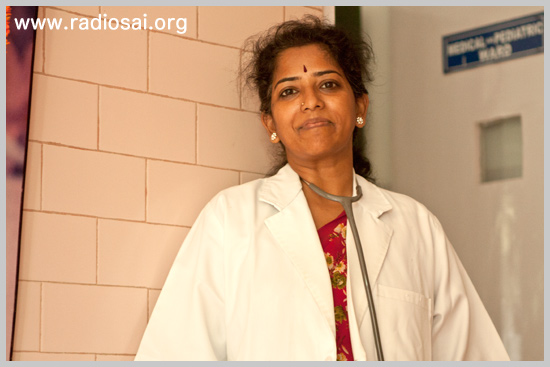 |
|
| Dr. Bhuvaneshwari, one of the many dedicated and devoted physicians at Baba's General Hospital in Puttaparthi. She has written a detailed thesis on snake bite victims and the optimization of ASV (anti- snake venom) usage and analysis of its outcome. |
Dr. S. Bhuvaneshwari explains in detail the condition of Narasimhulu when he came to the hospital and the diagnosis.
“From what he described to us, we concluded that when Narasimhulu slept in the field and woke up in the morning, he felt something had bitten him. He became weak and could hardly open his eyes. When he came here, the eyes were drooping and he had difficulty in swallowing which are neurotoxic (poisonous to nerve cells) symptoms, although he was breathing normally. There were no local bite marks or swelling. Therefore I guessed that it could be a Krait bite and started him immediately on anti-venom treatment.
“If he had not come here within five hours of the snake bite he would have probably had a respiratory arrest. Also possibly, the venom was not high or else he would not have survived for so long after the bite. For about two days he was not able to swallow and had general weakness. We gave him 13 vials of ASV (anti-snake venom). He did develop some reactions to ASV, but we had suitable medicines to take care of that,” she explains.
One of Many Such Incidents
According to Dr. Bhuvaneshwari who has done her Masters thesis on studying the snake bite cases in and around Puttaparthi, “From January 2009 to January 2010 we received 262 cases of snake bites, of which only 92 were venomous bites, the rest being non-venomous.
 |
 |
 |
 |
 |
 |
 |
 |
| Statistics from Dr. Bhuvaneshwari's study done at the Sri Sathya Sai General Hospital for the period Jan 2009 - Jan 2010 | |||||||
Most of the cases come between May and September – the time when the farmers work in their fields. Many a times the patients bring the snake along with them which makes it easier for us to identify the reptile and start the right medication immediately. In some cases, even though the snake is venomous, the patient develops the symptoms gradually. We keep such patients under observation and treat them based on the developing symptoms and their blood test reports.
“There are basically four kinds of snakes that we come across:
 |
 |
 |
 |
 |
 |
 |
 |
“The local symptoms of poisonous snake bite are consistent pain, immediate swelling and later blisters and necrosis (premature death of cells and living tissue; it is almost always detrimental and can be fatal). The symptoms vary according to the species. For example, the Saw Scaled Viper and Russell's Viper are Hemotoxic snakes which cause bleeding of gums, blood in the urine, local swelling and so on, while the Krait and the Cobra are Neurotoxic which result in symptoms like drooping of eye-lids, breathing and swallowing difficulties, necrosis, etc. Any of these bites can lead to death if not attended to immediately. The patient should reach the hospital within two hours.”
|
||||||||||||||||
The Treatment Process
Dr. S. Bhuvaneshwari who has now been treating snake bite patients in Baba's hospital for almost four years explains the course of treatment for snake bites. “Anti-Snake Venom (ASV) is the general treatment for Neurotoxic snakebites which was the case with Narasimhulu. Some patients develop reaction to ASV to counter which we give other medicines as we cannot reduce the dosage of ASV. Narasimhulu fortunately did not have any such adverse effects.
“In the case of a neuro-paralytic bite we need to give 15 vials of ASV; generally government hospitals do not have sufficient stock of this, they may not have more than four to five vials at any point in time. Each vial costs about Rs. 450 and most of these patients cannot afford it.
“Also another advantage we have in Puttaparthi is the tertiary care support available at the Super Speciality Hospital which is nearby; if the case is severe and the patient needs ventilator support we send them to this hospital. The recovery rate in our hospital has been 99 per cent; we lost only one patient last year to a Cobra bite, and this was because the patient came late.”
 |
 |
 |
 |
 |
 |
 |
 |
| Statistics from a study conducted in the Sri Sathya Sai General Hospital for the year 2009 | |||||||
The TLC (tender loving care) Experience
For Narasimhulu, the Sri Sathya Sai General Hospital is 'God's Hospital'. Extremely grateful for the free cure received, he says, “In Baba’s hospital, the nurses and doctors took good care of me. Soon, I was back to my earlier and normal self. If I had opted for treatment in Penukonda, it would have cost me at least Rs. 3000. Here, I did not have to spend anything; the only cost I incurred was the auto-rickshaw fare to the Hospital. God is really very kind and helpful to us. But for this Hospital, I would not have survived. Baba has given me back my life,” he says.
“In our village we have lost many lives because of snake bites. From now on, if anyone has any problem I will ask them to come straight to this hospital,” he adds.
After two days of treatment, Narasimhulu returned to his village, being able to swallow normally and also resume his work.
A Sacred Home of Healing
Yet another wonderful story from an institution where hope and love help yank thousands out of the deepest depths of despair. It is not only the patients who are benefitted, every physician who works here (and most of whom are voluntary) find serving in this hospital an elevating experience.
Dr. Amrad Lad, a busy family physician from Hamilton, New Zealand, says, “This year (2011) is the first time I have been granted the privilege to work at the Sri Sathya Sai General Hospital at Prashanti Nilayam. Words cannot describe the dedication and enthusiasm with which all the volunteers and permanent staff carry out their mission here in a loving and caring environment... Despite the heavy workload, I do not feel exhausted at the end of the day, in fact I feel energized and look forward to the next day's work. I feel a sense of calmness and satisfaction that I am doing justice to my profession. I am committed to return to this hospital in a few years' time, not only to serve but to experience the joy of my inner being.”
 |
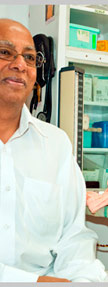 |
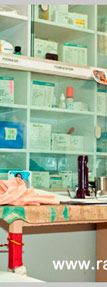 |
 |
 |
 |
 |
 |
| Dr. Amrad Lad from New Zealand offering his services at the General Hospital | |||||||
Another visiting doctor like Dr. Lad is Dr. Srinivas Reddy Puli, working currently as a Associate Professor in Gastroenterology at University of Illinois, USA. Earlier he did Advanced Endoscopy training at Harvard University, Boston, USA. “This is my second trip to volunteer as a Gastroenterologist in Puttaparthi. Everyday I volunteer at this Hospital, it gives me the satisfaction that I used the skills God gave me to help others who are less fortunate. Also, from Baba's teachings, I remember that what I carry with me is the good deeds I do. So, I want to come every year and help others who cannot get help at other hospitals. This way I can repay for some part of what I have been blessed with and also accrue some good karma to take with me.”
 |
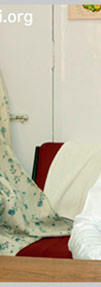 |
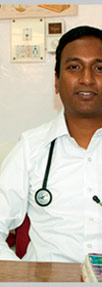 |
 |
 |
 |
 |
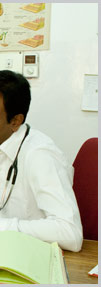 |
| Dr. Srinivas Reddy Puli, a gastroenterologist from the US during his second trip to serve at Baba's General Hospital | |||||||
It is this spirit of sacredness and selflessness that makes this Hospital so unique. In 2010 alone about 350000 patients were seen in its outpatient department and over 2000 babies were delivered. With 14 departments, 100 beds, 50 nurses and over 40 doctors this tiny oasis of love has been offering physical and mental solace to thousands every year.
On the fourth Annual Day of this Hospital in early 1960s, Baba had said, “This hospital serves to increase faith, demonstrate divinity and remove doubts...” And this is exactly what this hospital has done relentlessly for over five decades now. Anyone who steps into its portals returns recharged with faith in the power of Pure Love which truly is another name for divinity.
- Radio Sai Team














